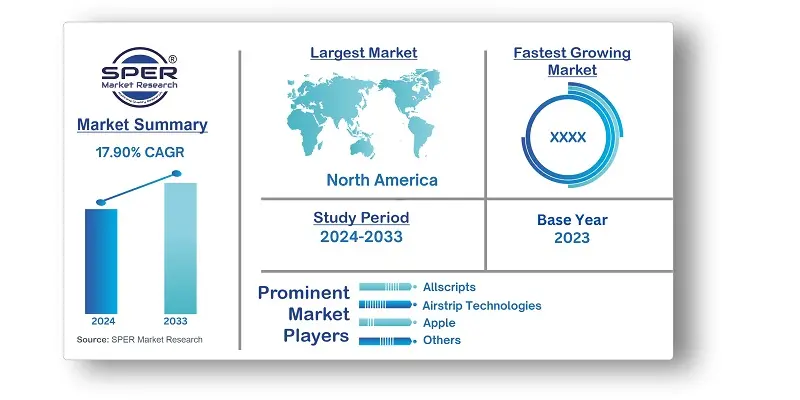
North America HealthTech Market Growth, Size, Trends, Demand, Revenue and Future Outlook
North America HealthTech Market Size- By Technology, By Component- Regional Outlook, Competitive Strategies and Segment Forecast to 2033
| Published: Apr-2024 | Report ID: HLCA2434 | Pages: 1 - 158 | Formats*: |
| Category : Healthcare | |||
- March 2020: During the COVID-19 pandemic, Allscripts launched FollowMyHealth, a telehealth tool to assist U.S. healthcare organisations with virtual patient visits.


| Report Metric | Details |
| Market size available for years | 2020-2033 |
| Base year considered | 2023 |
| Forecast period | 2024-2033 |
| Segments covered | By Technology, By Component |
| Regions covered | Canada, U.S. |
| Companies Covered | Allscripts, Airstrip Technologies, Apple, Inc, Cisco Systems Inc, Cerner Corp, Computer Programs and Systems, Inc, Epic Systems Corp, Google, Inc, IBM Corp, McKesson Corp, Qualcomm Technologies, Inc, QSI Management, LLC, Samsung Electronics Co Ltd, Softserve, Telefonica S.A., Vodafone Group, Others |
- Digital Health Startups
- Government and Regulatory Bodies
- Health Insurance Companies
- Healthcare Providers
- Investors and Venture Capitalists
- Medical Device Manufacturers
- Patients and Caregivers
- Pharmaceutical Companies
- Research Institutions and Academia
- Technology Companies
- Others
| By Technology: |
|
| By Component: |
|
| By Region: |
|
- North America HealthTech Market Size (FY’2024-FY’2033)
- Overview of North America HealthTech Market
- Segmentation of North America HealthTech Market By Technology (Digital Health Systems, Healthcare Analytics, Tele-healthcare)
- Segmentation of North America HealthTech Market By Component (Hardware, Services, Software)
- Statistical Snap of North America HealthTech Market
- Expansion Analysis of North America HealthTech Market
- Problems and Obstacles in North America HealthTech Market
- Competitive Landscape in the North America HealthTech Market
- Impact of COVID-19 and Demonetization on North America HealthTech Market
- Details on Current Investment in North America HealthTech Market
- Competitive Analysis of North America HealthTech Market
- Prominent Players in the North America HealthTech Market
- SWOT Analysis of North America HealthTech Market
- North America HealthTech Market Future Outlook and Projections (FY’2024-FY’2033)
- Recommendations from Analyst
1.1. Scope of the report1.2. Market segment analysis
2.1. Research data source2.1.1. Secondary Data2.1.2. Primary Data2.1.3. SPER’s internal database2.1.4. Premium insight from KOL’s2.2. Market size estimation2.2.1. Top-down and Bottom-up approach2.3. Data triangulation
4.1. Driver, Restraint, Opportunity and Challenges analysis4.1.1. Drivers4.1.2. Restraints4.1.3. Opportunities4.1.4. Challenges4.2. COVID-19 Impacts of the North America HealthTech Market
5.1. SWOT Analysis5.1.1. Strengths5.1.2. Weaknesses5.1.3. Opportunities5.1.4. Threats5.2. PESTEL Analysis5.2.1. Political Landscape5.2.2. Economic Landscape5.2.3. Social Landscape5.2.4. Technological Landscape5.2.5. Environmental Landscape5.2.6. Legal Landscape5.3. PORTER’s Five Forces5.3.1. Bargaining power of suppliers5.3.2. Bargaining power of buyers5.3.3. Threat of Substitute5.3.4. Threat of new entrant5.3.5. Competitive rivalry5.4. Heat Map Analysis
6.1. North America HealthTech Market Manufacturing Base Distribution, Sales Area, Product Type6.2. Mergers & Acquisitions, Partnerships, Product Launch, and Collaboration in North America HealthTech Market
7.1. North America HealthTech Market Value Share and Forecast, By Technology, 2024-20337.2. Digital Health Systems7.2.1. EHR7.2.2. E-Prescribing Systems7.3. Healthcare Analytics7.4. mHealth7.4.1. mHealth Apps7.4.2. Services7.4.3. Wearables7.5. Tele-healthcare7.5.1. Tele-care7.5.2. Telehealth
8.1. North America HealthTech Market Value Share and Forecast, By Component, 2024-20338.2. Hardware8.3. Services8.4. Software
9.1. North America HealthTech Market Size and Market Share
10.1. North America HealthTech Market Size and Market Share By Technology (2020-2026)10.2. North America HealthTech Market Size and Market Share By Technology (2027-2033)
11.1. North America HealthTech Market Size and Market Share By Component (2020-2026)11.2. North America HealthTech Market Size and Market Share By Component (2027-2033)
12.1. North America HealthTech Market Size and Market Share By Region (2020-2026)12.2. North America HealthTech Market Size and Market Share By Region (2027-2033)12.3. Canada12.4. U.S
13.1. Allscripts13.1.1. Company details13.1.2. Financial outlook13.1.3. Product summary13.1.4. Recent developments13.2. Airstrip Technologies13.2.1. Company details13.2.2. Financial outlook13.2.3. Product summary13.2.4. Recent developments13.3. Apple, Inc.13.3.1. Company details13.3.2. Financial outlook13.3.3. Product summary13.3.4. Recent developments13.4. Cisco Systems Inc.13.4.1. Company details13.4.2. Financial outlook13.4.3. Product summary13.4.4. Recent developments13.5. Cerner Corp.13.5.1. Company details13.5.2. Financial outlook13.5.3. Product summary13.5.4. Recent developments13.6. Computer Programs and Systems, Inc.13.6.1. Company details13.6.2. Financial outlook13.6.3. Product summary13.6.4. Recent developments13.7. Epic Systems Corp.13.7.1. Company details13.7.2. Financial outlook13.7.3. Product summary13.7.4. Recent developments13.8. Google, Inc.13.8.1. Company details13.8.2. Financial outlook13.8.3. Product summary13.8.4. Recent developments13.9. IBM Corp.13.9.1. Company details13.9.2. Financial outlook13.9.3. Product summary13.9.4. Recent developments13.10. McKesson Corp.13.10.1. Company details13.10.2. Financial outlook13.10.3. Product summary13.10.4. Recent developments13.11. Qualcomm Technologies, Inc.13.11.1. Company details13.11.2. Financial outlook13.11.3. Product summary13.11.4. Recent developments13.12. QSI Management, LLC13.12.1. Company details13.12.2. Financial outlook13.12.3. Product summary13.12.4. Recent developments13.13. Samsung Electronics Co. Ltd.13.13.1. Company details13.13.2. Financial outlook13.13.3. Product summary13.13.4. Recent developments13.14. Vodafone Group13.14.1. Company details13.14.2. Financial outlook13.14.3. Product summary13.14.4. Recent developments13.15. Others
SPER Market Research’s methodology uses great emphasis on primary research to ensure that the market intelligence insights are up to date, reliable and accurate. Primary interviews are done with players involved in each phase of a supply chain to analyze the market forecasting. The secondary research method is used to help you fully understand how the future markets and the spending patterns look likes.
The report is based on in-depth qualitative and quantitative analysis of the Product Market. The quantitative analysis involves the application of various projection and sampling techniques. The qualitative analysis involves primary interviews, surveys, and vendor briefings. The data gathered as a result of these processes are validated through experts opinion. Our research methodology entails an ideal mixture of primary and secondary initiatives.



Frequently Asked Questions About This Report
PLACE AN ORDER
Year End Discount
Sample Report
Pre-Purchase Inquiry
NEED CUSTOMIZATION?
Request CustomizationCALL OR EMAIL US
100% Secure Payment






Related Reports
Our Global Clients
Our data-driven insights have influenced the strategy of 200+ reputed companies across the globe.




















